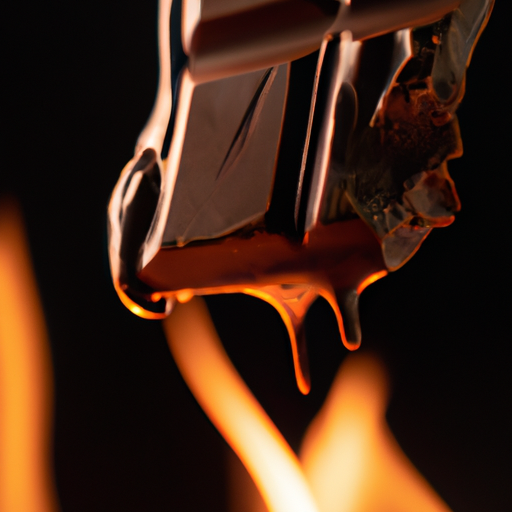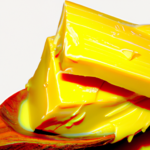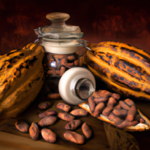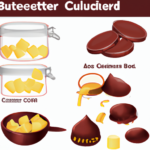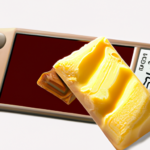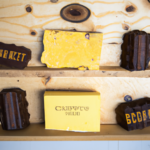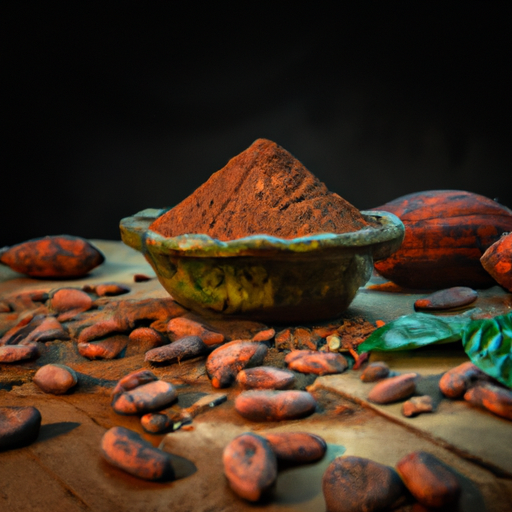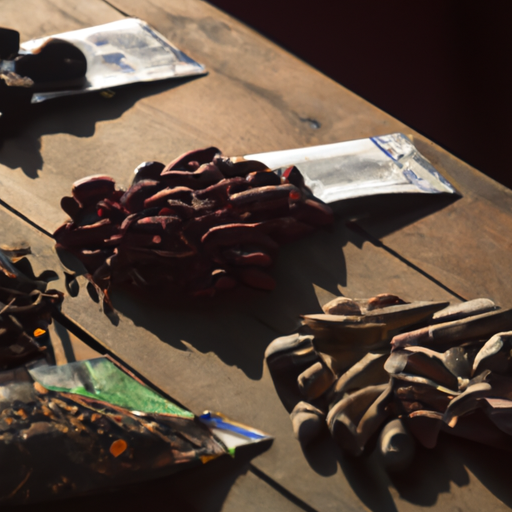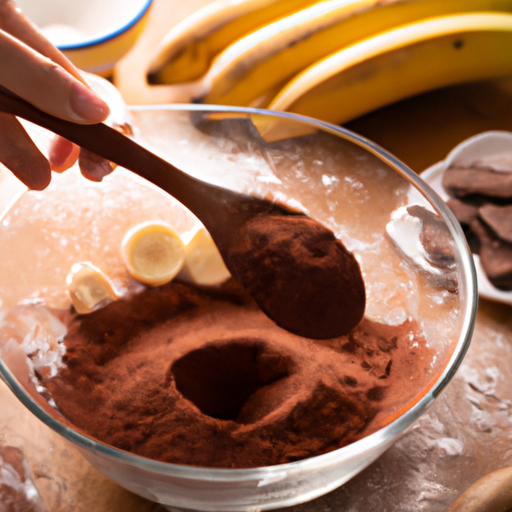Picture a luxurious substance that can take you on a journey to a realm of decadent flavors and indulgence. That’s exactly what raw cacao butter is – a rich treat made from the cacao bean.
As a lover of all things chocolate, I couldn’t wait to dive into the world of this magical ingredient and uncover its secrets. In this article, we will explore the origin and production process of cacao butter, its nutritional benefits, and its culinary uses.
We will also delve into the health benefits of consuming raw cacao butter and compare it to regular cocoa butter. Additionally, I will provide tips on how to store and use raw cacao butter, as well as share some delightful recipes and ideas to tantalize your taste buds.
So, if you’re ready to embark on a journey of chocolate bliss, let’s discover what raw cacao butter has to offer.
Key Takeaways
- Raw cacao butter should be stored in a cool, dry place away from sunlight and heat sources, and transferred to an air-tight container to protect from moisture and odors.
- In warm climates, it is recommended to refrigerate raw cacao butter for a longer shelf life, and for long-term storage, it can be frozen in a tightly sealed container.
- When using raw cacao butter in recipes, it enhances flavor and health benefits when melted gently, adds a smooth and creamy texture to desserts, adds depth of flavor to baked goods, and can be used in homemade skincare products.
- Raw cacao butter can be purchased at local health food stores, specialty grocery stores, and online from organic and natural product websites. It can also be made at home by grinding cocoa beans and separating the fat from the cocoa solids using a grinder or food processor.
The Origin and Production Process of Cacao Butter
Cacao butter, also known as the creamy result of cacao beans, undergoes a meticulous production process to bring out its decadent flavor.
The origin of cacao butter can be traced back to the cacao tree, which is native to the tropical regions of Central and South America.
The manufacturing process begins with the harvesting of ripe cacao pods, which are then cracked open to extract the beans. These beans are fermented and dried before being roasted to develop their rich flavor.
After roasting, the beans are ground into a paste, known as chocolate liquor. The liquor is then pressed to separate the cocoa solids from the cacao butter.
This pure cacao butter is then cooled and molded into solid blocks or used to make various chocolate products.
Now, let’s explore the nutritional benefits of raw cacao butter.
Nutritional Benefits of Raw Cacao Butter
Indulge in the velvety richness of this delectable treat, as it offers a multitude of nutritional benefits that will leave you feeling nourished and satisfied. Raw cacao butter is packed with essential nutrients, including healthy fats, vitamins, and minerals. It contains a high amount of antioxidants, which help protect the body from harmful free radicals. Additionally, raw cacao butter is a great source of magnesium, iron, and fiber.
To showcase the nutritional content of raw cacao butter, here is a table highlighting its key components:
| Nutrient | Amount per 100g |
|---|---|
| Fat | 100g |
| Vitamin E | 24mg |
| Magnesium | 72mg |
These nutrients contribute to improved heart health, brain function, and skin health.
Moving forward, let’s explore the culinary applications of raw cacao butter and how it can enhance your dishes without compromising on taste and health benefits.
Culinary Uses of Raw Cacao Butter
With its versatile nature, raw cacao butter can elevate the flavors of your favorite dishes while providing a healthy dose of nutrients.
Culinary uses of raw cacao butter are vast, making it a popular ingredient in both sweet and savory recipes. Its rich and creamy texture makes it a perfect addition to desserts like chocolate truffles, brownies, and fudge. Additionally, it can be used as a substitute for traditional butter or oil in baking, adding a unique chocolate flavor to cakes and cookies.
On the savory side, raw cacao butter can be melted and used as a base for sauces, dressings, and marinades, enhancing the overall taste of dishes. Its high content of antioxidants and healthy fats also adds to the benefits of consuming raw cacao butter.
Transitioning into the subsequent section about the health benefits of consuming raw cacao butter, it is important to note that these culinary uses are just the beginning of its potential benefits.
Health Benefits of Consuming Raw Cacao Butter
Raw cacao butter, a key ingredient in chocolate, has numerous health benefits that make it a valuable addition to a balanced diet.
Firstly, it is rich in antioxidants, which help protect the body against free radicals and reduce the risk of chronic diseases.
Additionally, consuming raw cacao butter promotes heart health by improving blood flow, lowering blood pressure, and reducing inflammation.
Finally, it has been shown to boost mood and brain function due to its content of various compounds that enhance neurotransmitter activity.
Rich in Antioxidants
Packed with a multitude of antioxidants, raw cacao butter is a true powerhouse for boosting your health. Antioxidants are compounds that help protect the body from oxidative stress caused by free radicals. Consuming antioxidant-rich foods, like raw cacao butter, can have a positive impact on various aspects of our health, including skin health. Antioxidants in skincare products can help reduce the signs of aging, improve skin elasticity, and promote a youthful glow.
To understand the potency of raw cacao butter’s antioxidants, let’s take a look at a comparison table:
| Antioxidant | Raw Cacao Butter | Blueberries | Green Tea |
|---|---|---|---|
| Vitamin C | High | Medium | Low |
| Vitamin E | High | Low | Low |
| Flavonoids | High | Medium | High |
As you can see, raw cacao butter surpasses other antioxidant-rich foods in terms of vitamin C, vitamin E, and flavonoid content. These antioxidants play a crucial role in promoting heart health, which will be discussed in the subsequent section.
Promotes Heart Health
Loaded with powerful antioxidants, raw cacao butter is a heart-healthy ingredient that can significantly improve cardiovascular well-being. Studies have shown that consuming raw cacao butter can help lower cholesterol levels, reducing the risk of heart disease.
The antioxidants present in cacao butter help prevent the oxidation of LDL cholesterol, which is known to contribute to the formation of plaque in the arteries. By reducing LDL oxidation, raw cacao butter promotes heart health and reduces the risk of cardiovascular diseases.
Additionally, the flavonoids found in cacao butter have been shown to improve blood flow and reduce blood pressure. These effects further contribute to the overall cardiovascular benefits of raw cacao butter.
Moving on to the next section, raw cacao butter also boosts mood and brain function.
Boosts Mood and Brain Function
Indulging in cacao butter is like giving your brain a gentle massage. It boosts mood and enhances cognitive function. It contains natural stimulants like theobromine and caffeine, providing a gentle and sustained energy boost without the jitters. These compounds improve blood flow to the brain, increasing alertness and improving focus.
Cacao butter is also rich in flavonoids, which have positive effects on brain health. These powerful antioxidants help protect brain cells from damage, reducing the risk of age-related cognitive decline.
Furthermore, cacao butter stimulates the production of endorphins, the feel-good hormones. This can improve mood and reduce stress.
Transitioning to the next section about raw cacao butter vs. regular cocoa butter, it’s important to understand the differences between the two for a better understanding of their benefits.
Raw Cacao Butter vs. Regular Cocoa Butter
When it comes to the comparison between raw cacao butter and regular cocoa butter, you’ll find a clear distinction in their nutritional profiles.
Raw cacao butter is made from the seeds of the cacao tree, while regular cocoa butter is derived from roasted cacao beans. This difference in processing affects the nutritional content of the two butters.
Raw cacao butter retains more of its natural antioxidants, vitamins, and minerals, making it a healthier option. It is also higher in polyphenols and flavonoids, which have been shown to have numerous health benefits.
Regular cocoa butter, on the other hand, may have a slightly milder taste and smoother texture due to the roasting process.
Understanding these differences can help you make an informed choice when using cacao butter in your recipes.
Moving on to how to store and use raw cacao butter…
How to Store and Use Raw Cacao Butter
When it comes to storing raw cacao butter, it’s important to keep it in a cool, dark place to prevent it from melting or becoming rancid.
I find that storing it in an airtight container in the refrigerator works best.
As for incorporating raw cacao butter into recipes, I’ve discovered that melting it gently over low heat and then adding it to smoothies, desserts, or homemade chocolate is a great way to enjoy its rich flavor and health benefits.
Proper Storage Methods
Proper storage methods for raw cacao butter are essential to maintain its aroma, texture, and taste. Follow these requirements for storing raw cacao butter:
-
Temperature: Keep raw cacao butter in a cool, dry place, away from direct sunlight and heat sources.
-
Air-tight container: Transfer the butter into an air-tight container to protect it from moisture and odors.
-
Refrigeration: If you live in a warm climate, refrigerate the cacao butter to prolong its shelf life.
-
Freezing: Consider freezing the butter in a tightly sealed container for long-term storage.
Proper storage preserves the freshness and quality of raw cacao butter, ensuring it remains ready for use in your favorite recipes.
Now, let’s move on to some tips for incorporating raw cacao butter into your culinary creations.
Tips for Incorporating into Recipes
Enhance your culinary creations with the velvety richness and irresistible aroma of raw cacao butter by following these creative tips for incorporating it into your favorite recipes.
When using this delightful ingredient in desserts, it is important to keep in mind its unique properties. Raw cacao butter has a high melting point, making it ideal for creating smooth and creamy textures in treats like truffles, fudges, and ganaches. Additionally, its rich flavor adds depth to baked goods like brownies and cookies.
But raw cacao butter isn’t just for the kitchen; it also offers benefits for skincare. Its natural moisturizing properties make it a great addition to homemade lotions, lip balms, and body butters.
So why stop at culinary delights? Explore the world of raw cacao butter recipes and ideas to take your creations to the next level.
Raw Cacao Butter Recipes and Ideas
To elevate your culinary creations, try incorporating raw cacao butter into your favorite recipes – it adds a velvety richness and irresistible depth of flavor. Raw cacao butter is not only a versatile ingredient in cooking, but it also offers various benefits for skincare. Its moisturizing properties make it a popular choice for homemade skincare products such as lotions and balms. Additionally, raw cacao butter can be blended into smoothies for a creamy texture and a burst of chocolaty goodness.
To highlight the versatility of raw cacao butter, here are some recipe ideas:
| Recipe | Ingredients | Instructions |
|---|---|---|
| Raw Cacao Butter Fudge | Raw cacao butter, raw cacao powder, honey | 1. Melt the raw cacao butter. 2. Mix in the raw cacao powder and honey. 3. Pour the mixture into a lined dish. 4. Refrigerate until firm. |
| Cacao Butter Cookies | Raw cacao butter, almond flour, maple syrup | 1. Cream the raw cacao butter and maple syrup. 2. Gradually add in the almond flour. 3. Form the dough into cookies. 4. Bake at 350°F for 10 minutes. |
These recipes showcase the incredible flavor and texture that raw cacao butter brings to dishes. Now let’s explore where to buy raw cacao butter.
Where to Buy Raw Cacao Butter
If you’re looking to elevate your culinary creations and add a touch of velvety richness and irresistible depth of flavor, finding a reliable source for high-quality raw cacao butter is essential.
There are several places where you can find high-quality raw cacao butter. One option is to visit your local health food store or specialty grocery store, as they often carry a variety of organic and raw ingredients.
You can also find raw cacao butter online, through websites that specialize in selling organic and natural products.
Another option is to make your own raw cacao butter at home by grinding cocoa beans and separating the fat from the cocoa solids. This allows you to have complete control over the quality and freshness of the cacao butter you use in your recipes.
Now, let’s move on to some FAQs about raw cacao butter.
FAQs about Raw Cacao Butter
Now that we know where to buy raw cacao butter, let’s explore some frequently asked questions about this amazing ingredient. As someone who is passionate about natural skincare, I have discovered the incredible benefits of raw cacao butter for the skin. It is packed with antioxidants that help fight free radicals and protect the skin from environmental damage. Additionally, its high content of fatty acids nourishes and moisturizes the skin, leaving it soft and supple. If you’re interested in making your own homemade raw cacao butter, it’s actually quite simple. All you need is raw cacao beans and a grinder or food processor. By grinding the beans until they turn into a smooth paste, you can then separate the cacao solids from the butter. The resulting rich and creamy cacao butter can be used in various skincare recipes for a luxurious and indulgent experience.
Frequently Asked Questions
Is raw cacao butter suitable for people with lactose intolerance or dairy allergies?
Raw cacao butter is a suitable alternative for those with lactose intolerance or dairy allergies. It is derived from the cacao bean and contains no lactose or dairy proteins, making it a safe option for individuals with these conditions.
Can raw cacao butter be used as a substitute for regular butter in baking?
Yes, raw cacao butter can be used as a substitute for regular butter in baking. It has a rich chocolate flavor and is packed with antioxidants, healthy fats, and minerals. To substitute, use equal amounts in recipes.
Does raw cacao butter contain caffeine?
Yes, raw cacao butter does contain caffeine. It is derived from the cacao bean, which naturally contains caffeine. Raw cacao butter also has numerous health benefits, and it differs from cocoa butter in terms of processing.
Can raw cacao butter be used for skincare or as a moisturizer?
Yes, raw cacao butter can be used for skincare and as a moisturizer. It is a natural alternative to shea butter, offering similar benefits for the hair, such as nourishment and hydration.
Is raw cacao butter safe for pregnant women or children to consume?
Raw cacao butter is safe for pregnant women to consume in moderate amounts, as it provides essential nutrients like iron and magnesium. However, it’s best to consult a healthcare professional. For children, cacao butter can be a nutritious addition to their diet, promoting healthy growth and development.
Can I Use Homemade Raw Cacao Butter in Recipes That Call for Store-Bought?
Yes, you can absolutely use making raw cacao butter in recipes that call for store-bought. Homemade raw cacao butter can be a great alternative and can give a unique flavor to your dishes. Just be sure to check the consistency and adjust as needed. Enjoy experimenting with your homemade cacao butter!
Conclusion
In conclusion, raw cacao butter is a truly remarkable ingredient that offers numerous nutritional and health benefits. Its origins and production process demonstrate the care and precision that goes into creating this natural product.
Whether used in culinary applications or for its health benefits, raw cacao butter is a versatile and valuable addition to any diet. As the saying goes, ‘Good things come to those who wait,’ and in the case of raw cacao butter, the patience and diligence are well worth it for the incredible rewards it brings.


